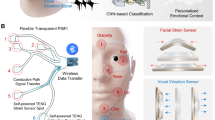Abstract
Our aim with Beauty Technology is to transform our body in an interactive platform by hiding technology into beauty products for creating muscle based interfaces that don’t give the wearer a cyborg look. FX e-makeup is a Beauty Technology prototype that applies FX makeup materials embedded with electronics for sensing the face’s muscles. This work presents Winkymote and Kinisi as proof of concept of the FX e-makeup.
Chapter PDF
Similar content being viewed by others
References
Vega, K.F.C., Fuks, H.: Empowering electronic divas through beauty technology. In: Marcus, A. (ed.) DUXU/HCII 2013, Part III. LNCS, vol. 8014, pp. 237–245. Springer, Heidelberg (2013)
Vega, K.: Exploring the power of feedback loops in wearables computers. In: Proceedings of the 7th International Conference on Tangible, Embedded and Embodied Interaction, TEI 2013, pp. 371–372. ACM, New York (2013)
Vega, K., Fuks, H.: Beauty technology as an interactive computing platform. In: Proceedings of the 2013 ACM International Conference on Interactive Tabletops and Surfaces, ITS 2013, pp. 357–360. ACM, New York (2013)
Jain, A.K., Li, S.Z.: Handbook of Face Recognition. Springer-Verlag New York, Inc., Secaucus (2005)
Lin, M., Li, B.: A wireless EOG-based human computer interface. Biomedical Engineering and Informatics (BMEI) 5, 1794–1796 (2010)
Curran, E., Sykacek, P., Stokes, M., Roberts, S., Penny, W., Johnsrude, I., Owen, A.: Cognitive tasks for driving a brain-computer interfacing system: a pilot study. IEEE Transactions on Neural Systems and Rehabilitation Engineering 12(1), 48–54 (2004)
Tanaka, K., Matsunaga, K., Kanamori, N., Hori, S., Wang, H.: Electroencephalogram-based control of a mobile robot. In: IEEE International Symposium on Computational Intelligence in Robotics and Automation, vol. 2, pp. 688–693 (2003)
Fabiani, G., McFarland, D., Wolpaw, J., Pfurtscheller, G.: Conversion of eeg activity into cursor movement by a brain-computer interface (bci). IEEE Transactions on Neural Systems and Rehabilitation Engineering 12(3), 331–338 (2004)
Kanade, T., Cohn, J., Tian, Y.: Comprehensive database for facial expression analysis. In: Proceedings of the Fourth IEEE International Conference on Automatic Face and Gesture Recognition, pp. 46–53 (2000)
Izard, C.E.: The maximally discriminative facial movement coding system. University of Delaware (1979)
Ekman, P., Friesen, W.: Facial Action Coding System: A Technique for the Measurement of Facial Movement. Consulting Psychologists Press, Palo Alto (1978)
Scherer, K., Ekman, P.: Handbook of methods in nonverbal behavior research, pp. 45–135. Cambridge University Press, New York (1982)
Chambayil, B., Singla, R., Jha, R.: Virtual keyboard BCI using eye blinks in EEG. In: 2010 IEEE 6th International Conference on Wireless and Mobile Computing, Networking and Communications (WiMob), pp. 466–470 (2010)
Królak, A., Strumiłło, P.: Eye-blink detection system for human-computer interaction. Universal Access in the Information Society 11(4), 409–419 (2012)
Bartlett, M.S., Hager, J.C., Ekman, P., Sejnowski, T.J.: Measuring facial expressions by computer image analysis. Psychophysiology 36, 253–263 (1999)
Cohn, J.F., Zlochower, A.J., Lien, J., Kanade, T.: Automated face analysis by feature point tracking has high concurrent validity with manual facs coding. Psychophysiology 36, 35–43 (1999)
Pantic, M., Patras, I., Rothkruntz, L.: Facial action recognition in face profile image sequences. In: IEEE International Conference on Multimedia and Expo, vol. 1, pp. 37–40 (2002)
Singla, R., Chambayil, B., Khosla, A., Santosh, J.: Comparison of SVM and ANN for classification of eye events in EEG. Journal of Biomedical Science and Engineering 4, 62–69 (2011)
Rantanen, V., Venesvirta, H., Spakov, O., Verho, J., Vetek, A., Surakka, V., Lekkala, J.: Capacitive measurement of facial activity intensity. IEEE Sensors Journal 13(11), 4329–4338 (2013)
Manabe, D.: Daito manabe, http://www.daito.ws/ (accessed April 4, 2010)
Saponas, T.S., Kelly, D., Parviz, B.A., Tan, D.S.: Optically sensing tongue gestures for computer input. In: Proceedings of the 22nd Annual ACM Symposium on User Interface Software and Technology, UIST 2009, pp. 177–180. ACM, New York (2009)
Vega, K.: Conductive makeup, http://katiavega.com (accessed April 4, 2010)
Gallagher, S.: Self-reference and schizophrenia: A cognitive model of immunity to error through misidentification. In: Exploring the Self: Philosophical and Psychopathological Perspectives on Self-Experience, pp. 203–239. John Benjamins (2000)
Tsakiris, M., Prabhu, G., Haggard, P.: Having a body versus moving your body: How agency structures body-ownership. Consciousness and Cognition 15(2), 423–432 (2006)
Tsakiris, M., Schutz-Bosbach, S., Gallagher, S.: On agency and body-ownership: Phenomenological and neurocognitive reflections. Consciousness and Cognition 16(3), 645–660 (2007)
William, E.R.: The neuropsychology of facial expression: A review of the neurological and psychological mechanisms for producing facial expressions. Psychological Bulletin 95, 52–77 (1984)
Duchenne de Boulogne, G.B.: The Mechanism of Human Facial Expression. Cambridge University Press (1990)
Paul Ekman, G.R., Hager, J.C.: Deliberate facial movement. Child Development 51, 886–891 (1980)
Gosselin, P., Perron, M., Beaupr, M.: The voluntary control of facial action units in adults. Emotion 10, 266–271 (2010)
Vega, K.: Kinisi, http://katiavega.com (accessed January 20, 2014)
Lathem, P.A., Gregorio, T.L., Garber, S.L.: High-level quadriplegia: an occupational therapy challenge. The American Journal of Occupational Therapy 39, 705–714 (2008)
Sipski, M.L., Richards, J.S.: Spinal cord injury rehabilitation, state of the science. American Journal of Physical Medicine & Rehabilitation 95, 310–342 (2006)
Author information
Authors and Affiliations
Editor information
Editors and Affiliations
Rights and permissions
Copyright information
© 2014 Springer International Publishing Switzerland
About this paper
Cite this paper
Vega, K., Arrieta, A., Esteves, F., Fuks, H. (2014). FX e-Makeup for Muscle Based Interaction. In: Marcus, A. (eds) Design, User Experience, and Usability. User Experience Design for Everyday Life Applications and Services. DUXU 2014. Lecture Notes in Computer Science, vol 8519. Springer, Cham. https://doi.org/10.1007/978-3-319-07635-5_61
Download citation
DOI: https://doi.org/10.1007/978-3-319-07635-5_61
Publisher Name: Springer, Cham
Print ISBN: 978-3-319-07634-8
Online ISBN: 978-3-319-07635-5
eBook Packages: Computer ScienceComputer Science (R0)




